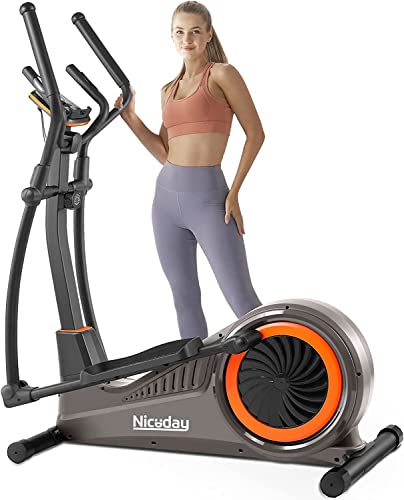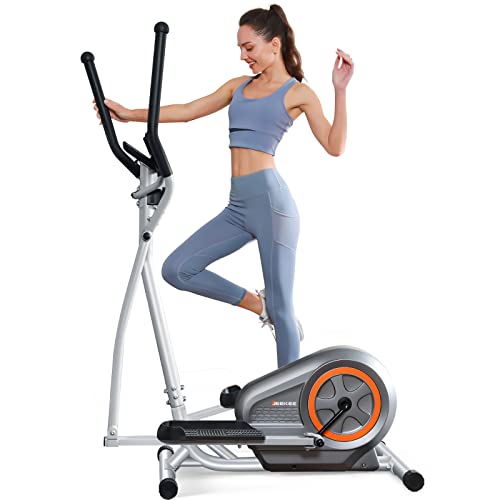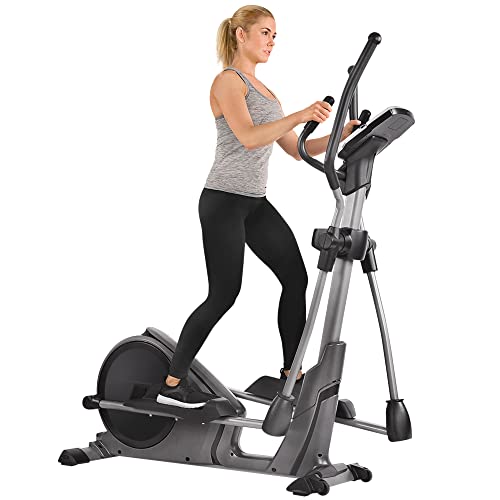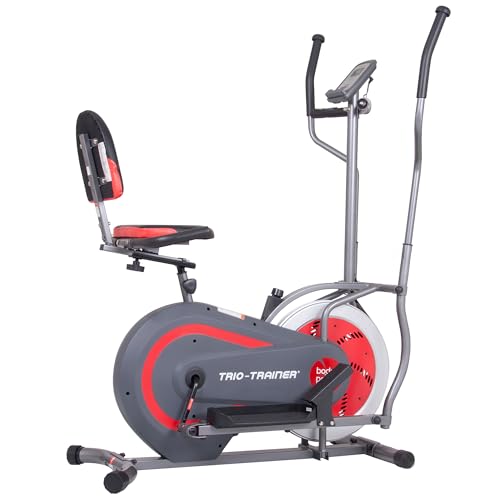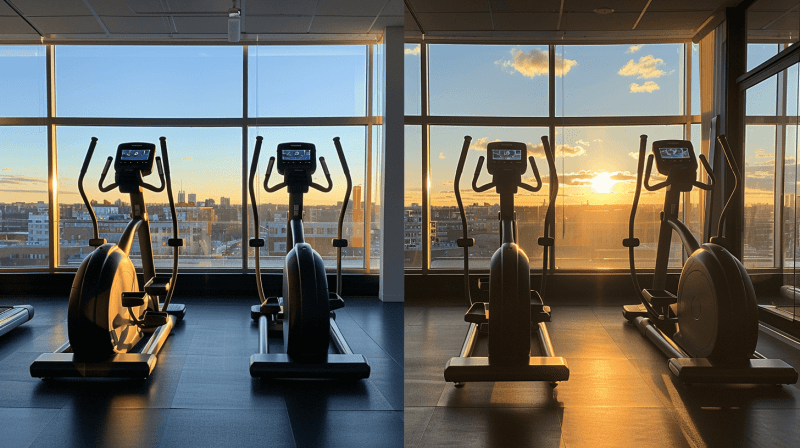While you might think the arm handles on an elliptical machine are just there for balance, they actually serve a much more significant purpose in your workout routine. When you're deciding whether to grip those moving handles or let your arms hang free, you'll need to ponder several factors that can impact your fitness results. The choice isn't simply a matter of personal preference—it's about understanding how different handlebar positions affect your muscle engagement, calorie burn, and overall exercise efficiency. What works best for your fitness goals may not align with what you've been told about proper elliptical use, and here's why.
Key Takeaways
-
Using the arm levers increases total calorie burn and provides a more complete full-body workout compared to hands-free exercise.
-
Proper handlebar use supports better posture and stability, especially when exercising at higher resistance levels.
-
Going hands-free occasionally helps improve balance and core strength while maximizing leg muscle engagement.
-
Alternating between using handles and going hands-free offers variety and targets different muscle groups effectively.
-
Using arm levers with proper form reduces strain on joints while distributing workout effort across multiple muscle groups.
Understanding Elliptical Machine Handlebars
Moving beyond basic functionality, elliptical machine handlebars play an essential role in enhancing your workout experience. When you use the handlebars, you're engaging your upper body and arms in ways that complement the lower body movements, creating a more thorough exercise routine. The integration of arm movements can considerably boost your overall calorie burn and elevate your heart rate compared to exercising without using the handlebars.
Understanding how to properly use the handlebars is vital for maximizing your workout benefits. While they're designed to provide upper body engagement, it's important to find the right balance in your workout approach. You'll want to avoid relying too heavily on the handlebars, as this can decrease the effectiveness of your leg and core muscle engagement during your session.
Your specific fitness objectives should guide your handlebar usage strategy. If you're aiming for a full-body workout, incorporating arm movements with moderate resistance can help you achieve your goals. However, if you're focusing primarily on lower body strength, you might choose to use the handlebars minimally or alternate between periods of use and non-use. Maintaining a soft elbow bend while gripping the handlebars helps ensure proper form and reduces upper body tension during your workout.
Benefits of Upper Body Engagement
Through effective upper body engagement on the elliptical machine, you'll access a range of benefits that transform your workout from a simple leg exercise into a thorough full-body training session. When you use the arms during your elliptical workout, you're activating multiple muscle groups, including your biceps, triceps, and shoulders, which substantially enhances the overall effectiveness of your exercise routine.
The decision to incorporate arm movements delivers multiple advantages for your fitness goals. You'll burn more calories and increase your energy expenditure compared to focusing solely on lower body movement. Additionally, the push-pull motion of the handles helps improve your posture and stability, particularly when you're working against higher resistance levels.
One of the most significant benefits of total body engagement is the distribution of effort across multiple muscle groups. By involving your upper body, you're reducing the strain on your legs while simultaneously improving your cardiovascular fitness. The coordinated movement of your arms and legs also enhances your balance and coordination, creating a more challenging and extensive workout experience that maximizes your exercise efficiency. Using the second set of handles provides the optimal way to engage your upper body muscles while maintaining proper form during your workout.
When to Go Hands-Free
Despite the benefits of upper body engagement, there are specific times when going hands-free on your elliptical can enhance your workout experience. If you're looking to improve your balance and core strength, removing your hands from the handles forces your body to engage stabilizing muscles more intensively, leading to better overall form throughout your session.
You'll find hands-free training particularly beneficial when you want to maximize leg muscle engagement and promote full-body coordination. This approach works well during lower-resistance workouts where maintaining stability is more manageable, allowing you to focus on proper posture and movement patterns without depending on arm support.
Consider going hands-free if you have limited arm mobility or find the traditional handle positions uncomfortable. However, it's important to recognize that working out without arm support may reduce your total calorie burn and power output. When attempting higher-resistance levels, you'll need to be especially mindful of your form throughout the exercise, as maintaining stability becomes more challenging without handle support. Start with shorter hands-free intervals and gradually increase duration as your balance and confidence improve. This low impact exercise approach helps protect your joints while still providing an effective workout that builds strength and cardiovascular fitness.
Proper Form and Technique
Proper form serves as the foundation for safe and effective elliptical workouts, whether you're using the handles or going hands-free. To maintain proper form and technique, keep your back straight, shoulders relaxed, and head aligned with your spine while looking forward. Your core should remain engaged throughout the exercise to support your posture and prevent unnecessary stress on your lower back.
When using the handles, focus on actively pushing and pulling them in a controlled manner that matches your leg movements. Your feet should remain flat against the pedals, and your knees shouldn't extend past your toes during the forward motion. Maintain a comfortable stride length that allows for full extension without overreaching or straining.
If you're exercising hands-free, place your arms in a natural running position with elbows bent at approximately 90 degrees. Keep your movements fluid and rhythmic, avoiding the tendency to bounce or sway side to side. Remember to distribute your weight evenly between both feet, and don't lean on the console or stationary handles for support, as this reduces the effectiveness of your workout. Total-body engagement can be maximized by coordinating your arm and leg movements in a smooth, controlled rhythm.
Maximizing Muscle Group Activation
To get the most out of your elliptical workout, try alternating between periods of using and not using the arm levers.
When you're using the handles, focus on maintaining proper form by actively pushing and pulling while keeping your posture upright.
As you become more advanced, you can incorporate longer periods of hands-free training to challenge your balance and intensify the workout for your legs and core muscles.
This versatile approach provides low-impact exercise benefits while allowing you to customize your workout intensity and muscle engagement.
Common Mistakes to Avoid
Many users' biggest mistake on the elliptical is relying too heavily on the arm handles. When you lean excessively on the handles, you reduce leg engagement and compromise your posture, which diminishes the effectiveness of your workout. Additionally, gripping the handles with unnecessary force creates unwanted tension in your wrists and arms, detracting from the intended full-body benefits.
Another common error occurs when exercisers aggressively pull or jerk the handles, which can destabilize their form and reduce control during the movement. Your core muscles should remain engaged throughout the session to maintain proper alignment and prevent overreliance on your upper body. Without proper core activation, you'll likely compensate by putting excessive stress on your arms.
To optimize your elliptical workout's effectiveness, you should alternate between using the handles and going hands-free. This variation guarantees balanced muscle engagement throughout your body and prevents developing poor movement patterns. When you do use the handles, maintain a light grip and focus on smooth, controlled movements while keeping your core tight and posture upright. For best results, incorporate interval training techniques by alternating between moderate-intensity periods and recovery sessions to maximize cardiovascular benefits.
Finding Your Personal Balance
How you balance your elliptical workout can enormously impact your results. Finding the right combination of hands-free and arm-assisted training depends on your specific fitness objectives and comfort level, while alternating between different hand positions helps create an extensive workout experience.
When determining your ideal approach to resistance training on the elliptical, consider these key factors:
- Your current fitness level and ability to maintain proper form during both hands-free and arm-assisted intervals
- Your upper body strength goals and desire for total-body engagement
- Your comfort level with varying resistance levels and workout intensities
Experimenting with different techniques allows you to discover what works best for your body. During higher resistance intervals, using the handles can provide added stability and upper body engagement, while hands-free sections at lower resistance help target your legs and core more effectively. If you're unsure about the best approach, working with a fitness professional can help you develop a personalized strategy that maximizes your elliptical workouts while maintaining proper form and achieving your specific fitness goals.
Training Goals and Handlebar Use
You can maximize your workout's effectiveness by incorporating both techniques based on your training objectives. For instance, if you're focusing on endurance, alternating between using the handlebars and going hands-free during your session creates a well-rounded body workout that targets different muscle groups.
The versatility of handlebar use allows you to customize your routine through interval training or pre-programmed workouts, ensuring you meet your specific fitness goals while maintaining engagement throughout your session. By strategically choosing when to use the handlebars, you'll create more dynamic workouts that align with your intended outcomes, whether that's improved cardiovascular fitness, enhanced muscle tone, or increased overall strength.
Alternating Methods for Best Results
Switching back and forth between handlebar and hands-free techniques creates an engaging and effective elliptical workout. You'll find that alternating methods helps maintain interest while ensuring your resistance levels are high enough to achieve a better workout overall.
To maximize your elliptical training, consider these proven alternating approaches:
- Use handlebars during high-resistance intervals to maintain stability and engage your upper body, then release them during recovery periods
- Incorporate pre-programmed workouts that naturally shift between arm-focused and legs-only segments
- Create custom intervals where you alternate between 2-minute handlebar segments and 1-minute hands-free portions
The key to successful alternation lies in finding the right balance for your fitness level and goals. When you're starting out, experiment with different combinations of hands-free and supported intervals until you discover what works best. You might prefer using handles during hill climbs and going hands-free on flats, or you could alternate based on time intervals. Remember that there's no one-size-fits-all approach, so don't hesitate to adjust your method as your fitness improves or your goals change.
Safety Considerations and Tips
While using an elliptical machine offers a low-impact workout, proper safety measures remain essential for preventing injuries and maximizing results. To guarantee a safe and effective cardio workout, you'll need to maintain proper form and posture, particularly when engaging the arm handles during your exercise routine.
Start by setting the resistance at a lower level to establish proper form and build your upper body strength gradually. As you monitor your heart rate and become more comfortable with the movement patterns, you can slowly increase the intensity of your workout.
When using the arm handles, avoid gripping them too tightly or pushing and pulling with excessive force, as this can lead to unnecessary strain on your joints. If you experience any discomfort in your shoulders, elbows, or back, it's pivotal to consult a fitness professional for guidance. They can evaluate your form and provide personalized recommendations based on your fitness level and any pre-existing conditions.
Remember to alternate between using the arm handles and going hands-free during your workouts, which helps create a balanced, full-body training approach while preventing overuse injuries.
Frequently Asked Questions
Should You Use Your Arms on an Elliptical?
You'll get the best results by using both approaches. Maintain proper arm positioning when using elliptical arm resistance, but also try hands-free sessions. This combination maximizes your workout benefits and targets different muscle groups.
Which Handles to Use on an Elliptical?
Get ready to supercharge your workout! You'll want to alternate between moving and static handles. Use proper elliptical arm form with moving handles for intensity, then switch to static ones for core engagement.
Should You Lift Your Heels on the Elliptical?
For proper foot placement, you can lift your heels periodically while maintaining effective stride technique. It's okay to alternate between lifted and flat heels based on your comfort level and fitness goals.
Can You Lose Belly Fat on an Elliptical?
You can reduce belly fat by using an elliptical with interval training routines and maintaining target heart rate zones. However, you'll need to combine this with a healthy diet for effective overall fat loss.
Conclusion
As they say, variety is the spice of life, and that's especially true with elliptical training. You'll get the most benefit by strategically mixing both hands-on and hands-free approaches based on your specific fitness objectives. Whether you're gripping those handles or letting your arms swing free, remember that proper form and consistent effort are what truly count. Choose the method that aligns with your goals, and you'll be on track for excellent results.

